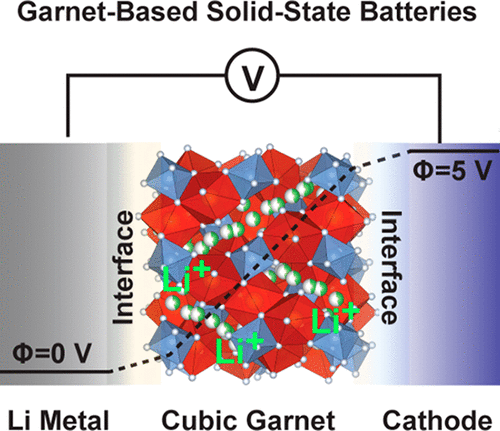当前位置:
X-MOL 学术
›
Chem. Rev.
›
论文详情
Our official English website, www.x-mol.net, welcomes your
feedback! (Note: you will need to create a separate account there.)
Garnet-Type Solid-State Electrolytes: Materials, Interfaces, and Batteries.
Chemical Reviews ( IF 51.4 ) Pub Date : 2020-04-09 , DOI: 10.1021/acs.chemrev.9b00427
Chengwei Wang 1 , Kun Fu 1, 2 , Sanoop Palakkathodi Kammampata 3 , Dennis W McOwen 1, 4 , Alfred Junio Samson 3 , Lei Zhang 1, 4 , Gregory T Hitz 1, 4 , Adelaide M Nolan 1 , Eric D Wachsman 1, 4 , Yifei Mo 1 , Venkataraman Thangadurai 3 , Liangbing Hu 1
Chemical Reviews ( IF 51.4 ) Pub Date : 2020-04-09 , DOI: 10.1021/acs.chemrev.9b00427
Chengwei Wang 1 , Kun Fu 1, 2 , Sanoop Palakkathodi Kammampata 3 , Dennis W McOwen 1, 4 , Alfred Junio Samson 3 , Lei Zhang 1, 4 , Gregory T Hitz 1, 4 , Adelaide M Nolan 1 , Eric D Wachsman 1, 4 , Yifei Mo 1 , Venkataraman Thangadurai 3 , Liangbing Hu 1
Affiliation

|
Solid-state batteries with desirable advantages, including high-energy density, wide temperature tolerance, and fewer safety-concerns, have been considered as a promising energy storage technology to replace organic liquid electrolyte-dominated Li-ion batteries. Solid-state electrolytes (SSEs) as the most critical component in solid-state batteries largely lead the future battery development. Among different types of solid-state electrolytes, garnet-type Li7La3Zr2O12 (LLZO) solid-state electrolytes have particularly high ionic conductivity (10–3 to 10–4 S/cm) and good chemical stability against Li metal, offering a great opportunity for solid-state Li-metal batteries. Since the discovery of garnet-type LLZO in 2007, there has been an increasing interest in the development of garnet-type solid-state electrolytes and all solid-state batteries. Garnet-type electrolyte has been considered one of the most promising and important solid-state electrolytes for batteries with potential benefits in energy density, electrochemical stability, high temperature stability, and safety. In this Review, we will survey recent development of garnet-type LLZO electrolytes with discussions of experimental studies and theoretical results in parallel, LLZO electrolyte synthesis strategies and modifications, stability of garnet solid electrolytes/electrodes, emerging nanostructure designs, degradation mechanisms and mitigations, and battery architectures and integrations. We will also provide a target-oriented research overview of garnet-type LLZO electrolyte and its application in various types of solid-state battery concepts (e.g., Li-ion, Li–S, and Li–air), and we will show opportunities and perspectives as guides for future development of solid electrolytes and solid-state batteries.
中文翻译:

石榴石型固态电解质:材料,界面和电池。
具有令人满意的优点(包括高能量密度,宽温度耐受性和较少的安全隐患)的固态电池已被认为是一种有前途的储能技术,可以替代以有机液体电解质为主的锂离子电池。固态电解质(SSE)作为固态电池中最关键的组件,在很大程度上引领着未来电池的发展。在不同类型的固态电解质中,石榴石型Li 7 La 3 Zr 2 O 12(LLZO)固态电解质具有特别高的离子电导率(10 –3至10 –4S / cm)和对锂金属的良好化学稳定性,这为固态锂金属电池提供了巨大的机会。自从在2007年发现石榴石型LLZO以来,人们对石榴石型固态电解质和所有固态电池的开发越来越感兴趣。石榴石型电解质已被认为是电池最有前途和最重要的固态电解质之一,在能量密度,电化学稳定性,高温稳定性和安全性方面具有潜在的好处。在这篇评论中,我们将研究石榴石型LLZO电解质的最新发展,并同时进行实验研究和理论结果的讨论,LLZO电解质的合成策略和修饰,石榴石固体电解质/电极的稳定性,新兴的纳米结构设计,降级机制和缓解措施,以及电池架构和集成。我们还将提供石榴石型LLZO电解质及其在各种类型的固态电池概念(例如Li-ion,Li–S和Li–air)中的面向目标的研究概况,并将展示机会以及作为未来固体电解质和固态电池开发指南的观点。
更新日期:2020-04-09
中文翻译:

石榴石型固态电解质:材料,界面和电池。
具有令人满意的优点(包括高能量密度,宽温度耐受性和较少的安全隐患)的固态电池已被认为是一种有前途的储能技术,可以替代以有机液体电解质为主的锂离子电池。固态电解质(SSE)作为固态电池中最关键的组件,在很大程度上引领着未来电池的发展。在不同类型的固态电解质中,石榴石型Li 7 La 3 Zr 2 O 12(LLZO)固态电解质具有特别高的离子电导率(10 –3至10 –4S / cm)和对锂金属的良好化学稳定性,这为固态锂金属电池提供了巨大的机会。自从在2007年发现石榴石型LLZO以来,人们对石榴石型固态电解质和所有固态电池的开发越来越感兴趣。石榴石型电解质已被认为是电池最有前途和最重要的固态电解质之一,在能量密度,电化学稳定性,高温稳定性和安全性方面具有潜在的好处。在这篇评论中,我们将研究石榴石型LLZO电解质的最新发展,并同时进行实验研究和理论结果的讨论,LLZO电解质的合成策略和修饰,石榴石固体电解质/电极的稳定性,新兴的纳米结构设计,降级机制和缓解措施,以及电池架构和集成。我们还将提供石榴石型LLZO电解质及其在各种类型的固态电池概念(例如Li-ion,Li–S和Li–air)中的面向目标的研究概况,并将展示机会以及作为未来固体电解质和固态电池开发指南的观点。































 京公网安备 11010802027423号
京公网安备 11010802027423号